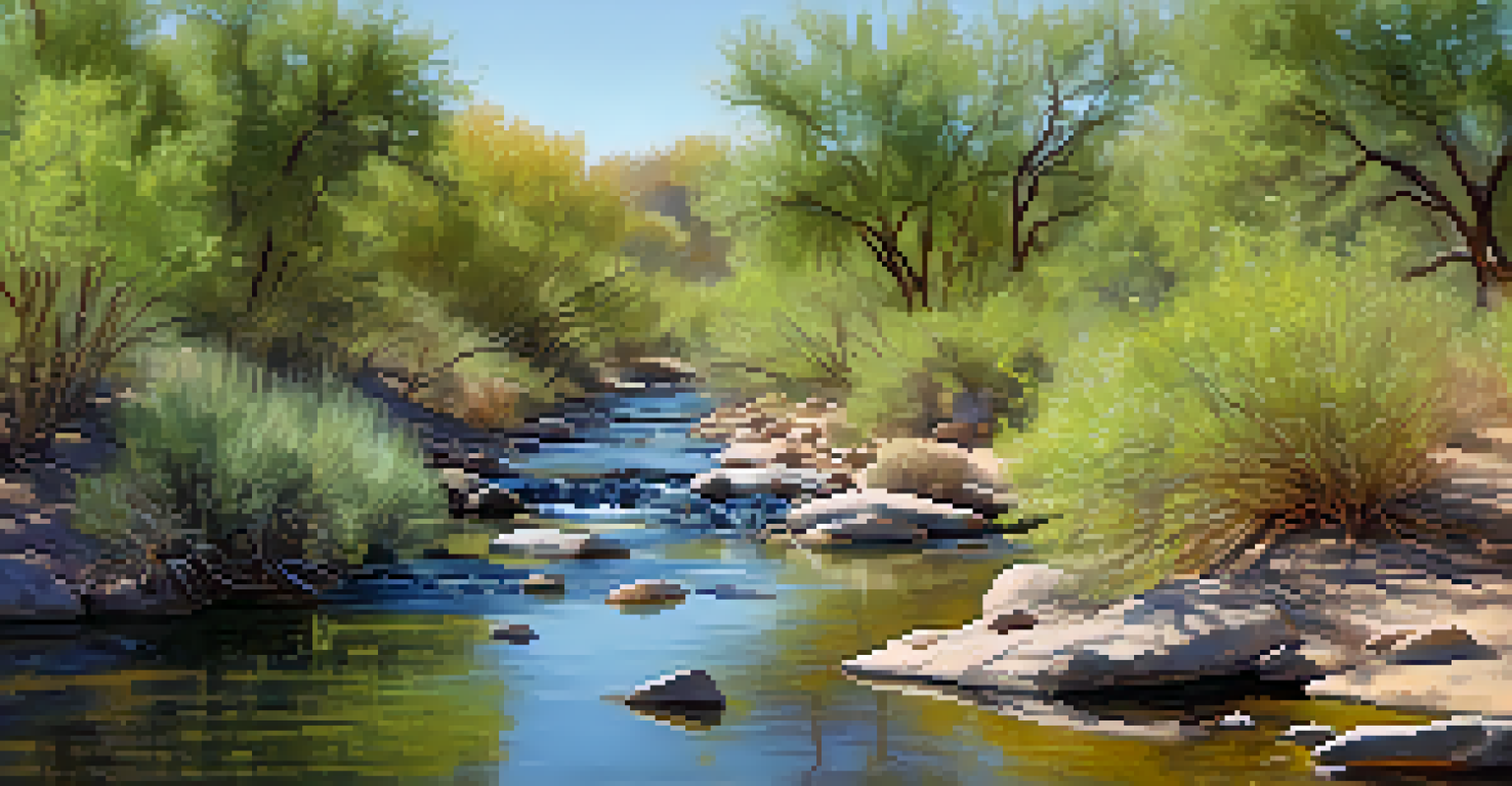Understanding Tucson's Desert Ecosystems: A Biodiversity Overview

Introduction to Tucson's Unique Desert Environment
Tucson, Arizona, is nestled in the Sonoran Desert, a stunning landscape that boasts a unique blend of flora and fauna. The region's climate is characterized by hot summers and mild winters, creating an environment that supports a diverse range of species. This desert ecosystem is not just barren sand; it’s a thriving habitat with intricate relationships among its inhabitants.
The desert is a natural extension of our individual selves, the same thin air that we inhale is also inhaled by all the creatures of the desert.
Understanding Tucson's desert ecosystems requires an appreciation of how life adapts to extreme conditions. Plants and animals here have evolved remarkable strategies for survival, from the iconic saguaro cactus storing water to the agile desert tortoise burrowing underground to escape the heat. Each organism plays a crucial role in maintaining the delicate balance of this ecosystem.
As we explore Tucson's biodiversity, we will uncover the fascinating interactions between species and their environments. From the towering cacti to the bustling wildlife, every element contributes to the vibrant tapestry of life that defines this desert region.
Key Flora: Iconic Plants of the Sonoran Desert
The Sonoran Desert is home to numerous plant species, many of which are uniquely adapted to the arid climate. The saguaro cactus is perhaps the most famous, reaching heights of up to 40 feet and living for over 150 years. These cacti are not just impressive in size; they provide essential habitats for various birds and mammals.

Another notable plant is the ocotillo, a spindly shrub that bursts into life with vibrant red flowers after rain. Its ability to thrive in harsh conditions exemplifies the resilience of desert flora. Other plants, like the creosote bush and mesquite tree, also play vital roles in the ecosystem, offering shelter and food for many desert animals.
Tucson's Unique Desert Ecosystem
Tucson's Sonoran Desert is a vibrant habitat where diverse flora and fauna have adapted to survive in extreme conditions.
By understanding these key plants, we gain insight into the intricate web of life that exists in Tucson's desert. Each species has adapted to its environment, showcasing nature's ingenuity and the importance of preserving these unique plants for future generations.
Diverse Wildlife: Animals of the Tucson Desert
Tucson's desert ecosystems are teeming with wildlife, from small insects to large mammals. Desert species such as the coyote, bobcat, and various reptiles have adapted to thrive in this challenging habitat. These animals often exhibit nocturnal behavior to avoid the scorching daytime heat, showcasing their unique survival strategies.
In every walk with nature one receives far more than he seeks.
Birdwatchers will delight in the variety of avian species that call Tucson home, including the Gambel's quail and the majestic golden eagle. The interplay between birds and plants is crucial for pollination and seed dispersal, highlighting the interconnectedness of desert life. Each animal plays a specific role in the ecosystem, contributing to its overall health and balance.
As we learn about these fascinating creatures, we can appreciate the complexity of their interactions within Tucson's desert ecosystems. Protecting these animals is essential for maintaining the biodiversity that enriches our environment.
The Role of Water in Desert Ecosystems
Water is a precious resource in the Sonoran Desert, and its availability significantly influences the local ecosystem. Seasonal rains can transform the landscape, causing plants to bloom and animals to emerge from hiding. This brief surge of life showcases the resilience of desert organisms, which have adapted to survive with minimal water.
Riparian areas, where water sources like rivers and streams are located, are hotspots of biodiversity. They support a higher concentration of plant and animal species compared to the surrounding desert. These areas play a crucial role in providing habitats and resources for wildlife, making them essential for the overall health of the ecosystem.
Impact of Water on Biodiversity
Water availability plays a crucial role in the desert ecosystem, impacting plant blooming and wildlife emergence.
Understanding the importance of water in Tucson's desert ecosystem emphasizes the need for conservation efforts. Protecting these vital resources ensures that the delicate balance of life can continue to thrive in this beautiful but challenging environment.
Human Impact on Desert Ecosystems
Human activities have significantly impacted Tucson's desert ecosystems, from urban development to agriculture. As the city grows, natural habitats are altered or destroyed, threatening the delicate balance of biodiversity. It's essential to recognize the consequences of our actions on the environment and find ways to coexist sustainably.
Invasive species also pose a significant threat to local ecosystems, outcompeting native plants and animals for resources. Efforts are underway to manage these invasive species and rehabilitate affected areas, highlighting the importance of preserving Tucson's unique biodiversity. Community involvement plays a vital role in these conservation initiatives.
By understanding the impact of human activity on desert ecosystems, we can make informed decisions that support biodiversity. It’s a shared responsibility to protect these fragile environments for future generations.
Conservation Efforts in Tucson's Desert
Conservation organizations and local governments are actively working to protect Tucson's desert ecosystems. Initiatives include habitat restoration, wildlife corridors, and educational programs aimed at raising awareness about the importance of biodiversity. These efforts are crucial in ensuring the survival of native species and their habitats.
Community involvement is also vital in conservation efforts. Local residents can participate in volunteer programs, such as tree planting or clean-up events, to directly contribute to the health of their environment. Every small action can lead to significant positive changes in preserving Tucson's rich biodiversity.
Human Impact and Conservation Efforts
Human activities threaten Tucson's desert biodiversity, making conservation initiatives essential for protecting native species and habitats.
Through collaborative efforts, Tucson's community is making strides in protecting its desert ecosystems. By embracing sustainability and conservation, we ensure that future generations can enjoy the beauty and diversity of this unique environment.
Conclusion: The Importance of Biodiversity in Tucson
Understanding Tucson's desert ecosystems and their biodiversity is essential for appreciating the intricacies of life in this unique environment. Each plant and animal plays a vital role in maintaining the balance of the ecosystem, highlighting the interconnectedness of all living things. By valuing and protecting this biodiversity, we contribute to the overall health of the planet.
The beauty of Tucson’s desert lies not only in its stunning landscapes but also in the resilience of its inhabitants. As we navigate the challenges posed by urbanization and climate change, it’s crucial to prioritize conservation efforts and promote sustainable practices. This ensures that the vibrant life of the desert continues to thrive.

In conclusion, fostering an appreciation for Tucson's biodiversity and ecosystems encourages a deeper connection to nature. Together, we can work towards a future where the desert remains a thriving habitat for generations to come.